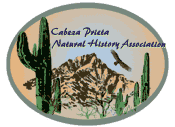
Cabeza Prieta Natural History Association
Sonoran Desert Reptiles
Lampropeltis getula (Common kingsnake)


|
Diet: snakes, lizards, birds, small mammals, frogs
Size: 36 - 45" |
Identification: 30 - 85 in. (76-216 cm). Over most of range in the west, pattern consists of alternating bands of plain-black or brown to dark brown and white or pale yellow, pale bands broadening on belly. Pattern alone will distinguish most individuals. In southern Arizona and New Mexico, however, light bands five way to varying amounts of light speckling on a dark background, and some individuals are entirely speckled. Other pattern type are found farther east. A black form without bands occurs in souther Arizona and a striped phase with more or less continuous pale yellow or whitish middorsal stripe occurs at scattered localities chiefly in southern California and Baja California. Individuals with a banded pattern but dusky above and dark below occur in costal Los Angeles county California. Black-bellied individuals with pale cross bands that broaden on lower sides to form a lateral stripe are found in northern part of San Joaquin Valley, California, also a report of such patterning from Palso Verdes Peninsula in southern California. Scales smooth and glossy, in 19 - 25 rows at midbody. Caudals divided. Anal single. Young: Usually patterned like adult, but in southern Arizona blotched at first, becoming spotted with age. Est snakes (including rattlers), lizards, small turtles, reptile eggs, frogs, birds and their eggs, and small mammals.
References
|
Photo Credits:
Photo #1
Photo #2
Copyright Creative Commons
HTML & Programing by
Thomas R. Powell